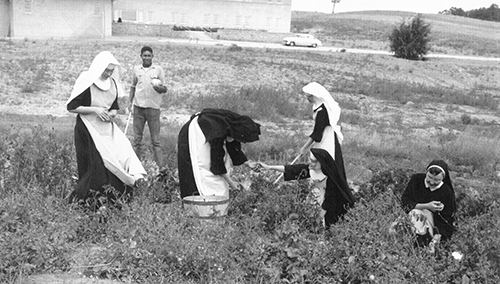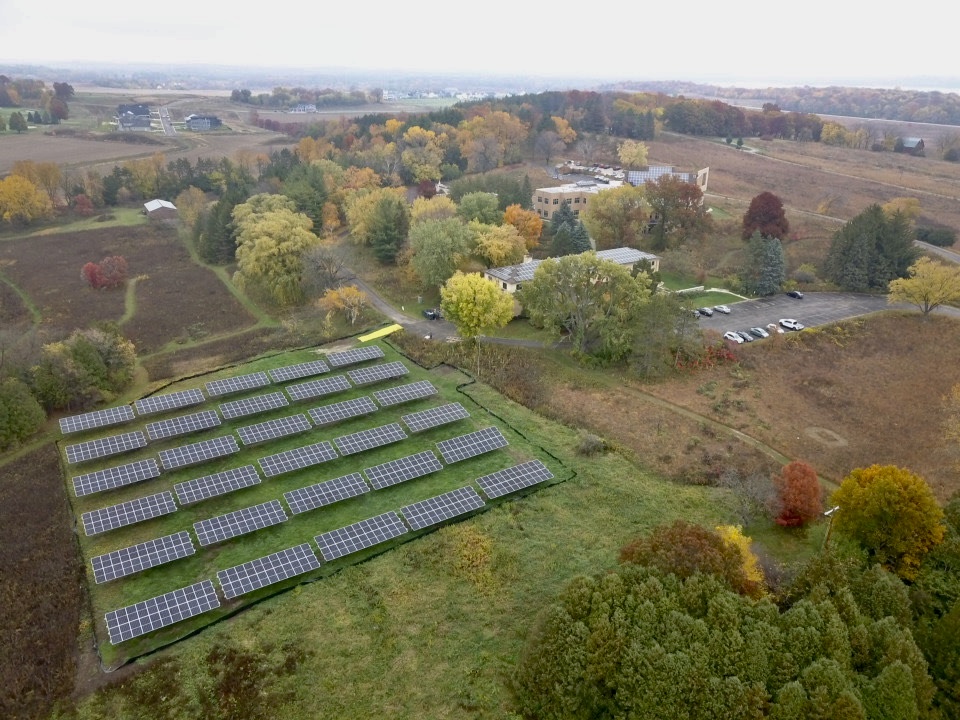Located just 4 miles from downtown Middleton, Holy Wisdom Monastery sits on 130 acres of restored prairie surrounded by an oak forest with a small glacial lake. Since the Benedictine Sisters of Holy Wisdom began stewarding this land in 1953, they have found a balance of embracing innovation while upholding tradition.
Their mission—to weave prayer, hospitality, justice, and care for the earth into a shared way of life—has led them on a journey with remarkable milestones: restoring over 100 acres of native prairie and constructing one of the ‘greenest’ LEED certified buildings in the country. But their next endeavor may be their most ambitious: achieving net-zero carbon emissions by the end of this year.
“Because of our mission, we have always wanted to reach net zero,” said Toby Grabs, Director of Operations at Holy Wisdom. “But even with all the mission mandate in the world, if we can’t pay for it, it’s not going to happen.”
Their road to net zero was paved in 2022 when President Biden signed the Inflation Reduction Act (IRA) into law. Most people know the IRA as the largest clean energy investment in American history. IRA incentives empower individuals and businesses to make energy efficient choices that save money and reduce pollution. Tax credits from the IRA allow most Americans to get money back when they weatherize their home, purchase an electric vehicle, or upgrade their appliances.
But how could a tax-exempt entity like Holy Wisdom benefit from tax credits? The answer is found in a provision of the IRA known as direct pay. This provision extends tax credits for qualifying clean energy projects to tax-exempt entities like local governments, churches, and schools. For the first time, these entities can receive a payment from the IRS equal to the tax credit amount for clean energy projects in the private sector.
“For non-profits, direct payment is huge,” said Mark Hanson, Director of Sustainable Services at Hoffman Planning, Design & Construction. Hanson has been working with Holy Wisdom for 18 years. This partnership included planning for the new monastery building completed in 2009, which achieved the highest LEED rating of any building at the time for its sustainable design and construction.
Prompted by the need to replace a failing gas boiler in the monastery’s Retreat and Guest House, Holy Wisdom Monastery worked with Hanson to explore options for additional on-site solar PV to generate 100% of their energy needs on a net basis. “We had a couple different options,” said Grabs. “One was to keep nursing our old gas boiler system along; another option was to replace the old gas boiler system with a new gas system. But after consulting with Mark Hanson, we realized that it would be cheaper to install geothermal when we factored in incentives from the IRA and grants from the Office of Energy Innovation.”
“With the IRA, you get the 30% tax credit for geothermal, plus another 10% [bonus credit] for the domestic content. There comes a tipping point where your [installation] costs for geothermal come out lower than conventional [gas] and, in most cases, with lower operating costs. That’s the scenario at Holy Wisdom,” said Hanson.
Coupling 145 kW of existing rooftop solar and 300 kW of new ground mounted solar with a geothermal system that has a lower cost than other options is a sound choice to minimize first-cost and operate with affordable, renewable energy. All said, Hanson estimates that Holy Wisdom will receive about $1 million back through the IRA.
“When you think of all the factors, the gas boiler going out, the fact that caring for the earth is part of our mission, a $575,000 grant from the Office of Energy Innovation, it was really the IRA that made this move financially feasible.” said Erin Trondson, Executive Director of Holy Wisdom.

IRA credits will be paid directly to Holy Wisdom for 40% of costs to replace the failing gas-fired HVAC system with a geothermal system, as well as 30% of costs to install a battery system that will store excess energy produced by the Monastery’s solar panels. Since the solar panels were funded by a third-party investor, tax credits for the new 300 kW solar array go to a separate LLC.
The Benedictine Women of Madison Solar LLC, co-owned by developer John Young of GSD Solar and the sisters of Holy Wisdom, claimed the solar tax credits. The LLC was among the first, if not the first, entities in Wisconsin to register a project using the new IRS portal that enables the transfer of these credits.
“Our solar project was in the works prior to the Inflation Reduction Act being passed, so we just coincidentally had a project that was able to leverage the IRA very quickly,” said Young. “The IRA allows us to sell these credits, and there is a big market out there for the sale of these credits.” Young envisions using money from the sale of credits to fund future solar projects.
“The Inflation Reduction Act changed everything,” concluded Grabs. Investments in clean energy by local governments, school districts, and nonprofits like Holy Wisdom, are critical for our transition to a clean energy economy. The IRA, and its direct pay provision, even the playing field to make clean energy projects as cost-effective for tax-exempt entities as they are for tax-paying entities.
You can learn more about Holy Wisdom and support their Sustainable Energy Initiative at www.holywisdommonastery.org.

